
Does pruning bearing almond trees benefit yield? Decades of UC research says it doesn’t. That’s according to UCCE Farm Advisor Roger Duncan who has studied multiple trials on the subject and conducted his own study over the course of more than two decades. The bottom line, he said, is pruning doesn’t improve yield in the short term and does not maintain yield in the long term any better than unpruned trees.
Duncan said he first started paying attention to the idea of not pruning after following studies done in the 80s and 90s and was skeptical at first. The first study he watched, a 21-year trial in Arbuckle, Calif., showed the yield of the pruned trees was not significantly different than that of the non-pruned trees and showed a reduced yield. Similar trials that have been replicated since showed the same results.
“I was not wholly convinced when I started, but now I’m convinced,” he said. “At some point, you have to believe the numbers.”
Those numbers included the evidence of slightly lower yields in annually pruned trees compared to unpruned trees across multiple trials done by different people in multiple areas of the state. Then you factor in the labor savings of not pruning.
When an 11-year trial was repeated in Kern County, it showed the same results, Duncan said. That trial was conducted on a different soil type than the initial studies: a sandy loam with vigorous soil and a vigorous orchard.
“There was really, statistically speaking, no difference. But again, the trend was just slightly higher yields in the unpruned trees,” he said. “So, why spend the money to not make a difference?”
Duncan’s own 21-year trial in Stanislaus County, which he finished in 2019, mirrored the others. Again, it showed there was no benefit at all in terms of yield. And that seems to be a trend worldwide, he said, citing pruning studies in Spain and Australia.
“It’s really consistent information that pruning almond trees definitely doesn’t improve yield in the short term, but the bigger surprise is it doesn’t improve the longevity of the orchard either,” he said.
The results of Duncan’s trial concluded at average almond prices and labor costs, conventional training and annual pruning would have reduced cumulative net income by up to $14,000 per acre over 19 years. That included pruning, stacking and shredding costs plus slightly lower cumulative yield.
It was that potential to help growers save money that drew Duncan to conduct his study.
“We’re always trying to save money or improve efficiencies in our farming operations, especially under the current financial pressures almond growers are facing, and it was a curiosity for me. I saw information coming from other parts of the state and I thought our growers here need to see this,” he said.
Other evidence across the trials also showed the vigor of the tree made no difference in the need to prune as far as yield is concerned, he said.
“I think some people feel maybe it works in a lower-vigor situation, but not at a high-vigor situation, but that’s not true either,” he said.
He added they also tested plantings at various tree spacings, from 10-foot spacing down the row all the way up to 22-foot spacing and found the same thing to be true. In fact, closely spaced trees require less pruning because the trees stay smaller through competition. Smaller trees have fewer problems with scaffold failure.

Many Still Pruning
There may be other reasons a grower chooses to prune. New trees should be trained for one to three years to establish a strong tree architecture. Occasionally, branches that get in the way of orchard equipment or are a hazard to equipment operators need to be removed in mature orchards. The same is true for broken or diseased limbs. Some growers may want to remove dead branches to reduce the number of sticks at harvest. And for some, the aesthetics of an orchard is important, with trees seen as an extension of one’s front yard. After all, a pruned orchard looks nice and clean. For others, it might be because the rejuvenation seen after pruning gives growers a sense of yield improvement.
Duncan was surprised by the number of growers he saw who were still choosing to prune after this past harvest season.
“I was expecting this year in particular that most growers would skip it, but I saw many that did not,” he said.
Mel Machado, Vice President of Member Relations at Blue Diamond, said he was flabbergasted by the amount of pruning he was seeing after harvest. Machado, who grows almonds in Oakdale, Calif., said in times of fiscal adversity, pruning is the first thing that goes out the window.
“To me, it’s a no brainer, if I’m struggling to find pennies, that’s an easy call, take that money and put it toward pest management,” he said.

He agrees that pruning is necessary for training young trees in the first several years of an orchard’s life and said he can even understand pruning all the way up to about the seventh year in extremely vigorous trees, but beyond that, he said it just doesn’t make sense from a budget standpoint.
“If you’re under five, six years old, yeah, there are reasons to prune,” he said, “but a 15- to 20-year-old orchard, what are you doing?”
Recommendations for Pruning
UCCE recommends to growers who do choose to prune to try to maintain as much fruit wood as possible by limiting pruning to taking out dead and diseased wood and branches that are in the way. And if you do choose to continue pruning, there are a couple of important protocols to keep in mind.
Watching the weather before pruning is probably the most important thing to consider, according to Duncan, who said if you are going to prune, be sure not to do it ahead of a rain event, especially if you’re going to make big cuts to scaffolds on young trees. He said they have been seeing a lot of problems with fungal canker diseases after pruning.
“So, I guess that’s another positive to not pruning; you’re reducing access of these fungal pathogens into the tree,” he said.
Again, he said pruning does have a fundamental role in training scaffolds in the first couple of years of a tree’s life, but it will not improve yield in the long term.
“There are reasons for pruning, but yield is not one of them,” Duncan said.
Duncan’s write up on his study can be found at https://www.sjvtandv.com/blog/tight-budget-consider-not-pruning-bearing-almond-orchards.

Kristin Platts | Digital Content Editor and Social Correspondence
Kristin Platts is a multimedia journalist and digital content writer with a B.A. in Creative Media from California State University, Stanislaus. She produces stories on California agriculture through video, podcasts, and digital articles, and provides in-depth reporting on tree nuts, pest management, and crop production for West Coast Nut magazine. Based in Modesto, California, Kristin is passionate about sharing field-driven insights and connecting growers with trusted information.















